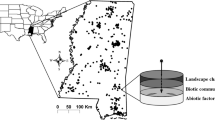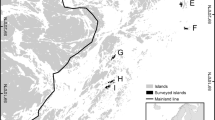Abstract
A number of hypotheses exist to explain species’ distributions in a landscape, but these hypotheses are not frequently utilized to explain the differences in native and exotic species distributions. The core-satellite species (CSS) hypothesis predicts species occupancy will be bimodally distributed, i.e., many species will be common and many species will be rare, but does not explicitly consider exotic species distributions. The parallel dynamics (PD) hypothesis predicts that regional occurrence patterns of exotic species will be similar to native species. Together, the CSS and PD hypotheses may increase our understanding of exotic species’ distribution relative to natives. We selected an old field undergoing secondary succession to study the CSS and PD hypotheses in conjunction with each other. The ratio of exotic to native species (richness and abundance) was observed through 17 years of secondary succession. We predicted species would be bimodally distributed and that exotic:native species ratios would remain steady or decrease through time under frequent disturbance. In contrast to the CSS and PD hypotheses, native species occupancies were not bimodally distributed at the site, but exotic species were. The exotic:native species ratios for both richness (E:Nrichness) and abundance (E:Ncover) generally decreased or remained constant throughout supporting the PD hypothesis. Our results suggest exotic species exhibit metapopulation structure in old field landscapes, but that metapopulation structures of native species are disrupted, perhaps because these species are dispersal limited in the fragmented landscape.




Similar content being viewed by others
References
Baer SG, Engle DM, Knops JMH, Langeland KA, Maxwell BD, Menalled FD, Symstad AJ (2009) Vulnerability of rehabilitated agricultural production systems to invasion by non-target plant species. Environ Manage 43:189–196
Bauer JT (2012) Invasive species: “back-seat drivers” of ecosystem change? Biol Invasions 14:1295–1304
Bazzaz FA (1968) Succession on abandoned old fields in the Shawnee Hills, Southern Illinois. Ecology 49:924–936
Bernard-Verdier M, Hulmer PE (2015) Alien and native plant species play different roles in plant community structure. J of Ecol 104. In press
Brandon AL, Gibson DJ, Middleton BA (2004) Mechanisms for dominance in an early successional old field by the invasive non-native Lespedeza cuneata (Dum. Cours.) G. Don. Biol Invasions 6:483–493
Cadotte MW, Lovett Doust J (2007) Core and satellite species in degraded habitats: an analysis using Malagasy tree communities. Biodivers Conserv 16:2515–2529
Collinge SK, Ray C (2009) Transient patterns in the assembly of vernal pool plant communities. Ecology 90:3313–3323
Collins SL, Glenn SM, Gibson DJ (1995) Experimental analysis of intermediate disturbance and initial floristic composition: decoupling cause and effect. Ecology 76:486–492
Collins B, Wein G, Phillipi T (2001) Effects of disturbance intensity and frequency on early old-field succession. J Veg Sci 12:721–728
Connell JH (1978) Diversity in tropical rainforests and coral reefs. Science 199:1302–1310
Cramer VA, Hobbs RJ, Standish RJ (2008) What’s new about old fields? Land abandonment and ecosystem assembly. Trends Ecol Evol 23:104–112
Daubenmire R (1959) A canopy-coverage method of vegetational analysis. Northwest Sci 33:43–64
Davis MA, Grime JP, Thompson K (2000) Fluctuating resources in plant communities: a general theory of invasibility. J Ecol 88:528–534
DiVittorio CT, Corbin JD, D’Antonio CM (2007) Spatial and temporal patterns of seed dispersal: an important determinant of grassland invasion. Ecol Appl 17:311–316
Fridley JD, Brown RL, Bruno JF (2004) Null models of exotic invasion and scale-dependent patterns of native and exotic species richness. Ecology 85:3215–3222
Gibson DJ, Ely JS, Collins SL (1999a) The core-satellite species hypothesis provides a theoretical basis for Grime’s classification of dominant, subordinate, and transient species. J Ecol 87:1064–1067
Gibson DJ, Middleton BA, Saunders GW, Mathis M, Weaver WT, Neely J, Rivera J, Oyler M (1999b) Learning ecology by doing ecology: long-term field experiments in succession. Am Biol Teach 61:217–222
Gibson DJ, Middleton BA, Foster K, Honu YAK, Hoyer EW, Mathis M (2005) Species frequency dynamics in an old-field succession: effects of disturbance, fertilization and scale. J Veg Sci 16:415–422
Gotelli NJ, Simberloff D (1987) The distribution and abundance of tallgrass prairie plants: a test of the core-satellite hypothesis. Am Nat 130:18–35
Grace JB (1999) The factors controlling species density in herbaceous plant communities: an assessment. Perspect Plant Ecol Evol Syst 2:1–28
Grime JP (1977) Evidence for the existence of three primary strategies in plants and its relevance to ecological and evolutionary theory. Am Nat 111:1169–1194
Hanski I (1982) Dynamics of regional distribution: the core and satellite species hypothesis. Oikos 38:210–221
Hill MO, Roy DB, Thompson K (2002) Hemeroby, urbanity and ruderality: bioindicators of disturbance and human impact. J Appl Ecol 39:708–720
Hobbs RJ, Huenneke LF (1992) Disturbance, diversity, and invasion: implications for conservation. Conserv Biol 6:324–337
Huston MA (1999) Local processes and regional patterns: appropriate scales for understanding variation in the diversity of plants and animals. Oikos 86:393–401
Kammer PM, Vonlanten CM (2009) The shape of occupancy distributions in plant communities: the importance of artefactual effects. Web Ecol 9:8–23
Littell RC, Milliken GA, Stroup WW, Wolfinger RD (1996) SAS system for mixed models. SAS Institute Inc., Cary
Maalouf JP, Bagousse-Pinguet YL, Marchand L, Touzard B, Michalet R (2012) The interplay of stress and mowing disturbance for the intensity and importance of plant interactions in dry calcareous grasslands. Ann Bot 110:821–828
MacDougall AS, Turkington R (2005) Are invasive species the drivers or passengers of change in degraded ecosystems? Ecology 86:42–55
MacDougall AS, Bennett JR, Firn J, Seabloom EW, Borer ET, Lind EM, Orrock JL, Harpole WS, Hautier Y, Adler PB, Cleland E, Davies K, Melbourne B, Prober SM, Bakker JD, Fay PA, Jin VL, Kendig A, LaPierre KJ, Moore J, Morgan J, Stevens CJ (2014) Anthropogenic-based regional-scale factors most consistently explain plot-level exotic diversity in grasslands. Glob Ecol Biogeogr 7:802–810
Martinez KA (2014) C3 grass seedling invasibility and secondary succession trends in an old field in southern Illinois. Southern Illinois University Carbondale, Thesis
McKinney ML (2004) Do exotics homogenize or differentiate communities? Roles of sampling and exotic species richness. Biol Invasions 6:495–504
McLane CR, Battaglia LL, Gibson DJ, Groninger JW (2011) Succession of exotic and native species assemblages within restored floodplain forests: a test of the parallel dynamics hypothesis. Restor Ecol 20:202–210
Orr SP, Rudgers JA, Clay K (2005) Invasive plants can inhibit native tree seedlings: testing potential allelopathic mechanisms. Plant Ecol 181:153–165
Simberloff D, Von Holle B (1999) Positive interactions of non-indigenous species: invasional meltdown? Biol Invasions 6:21–32
Sandel B, Corbin JD (2012) Scale-dependent responses of species richness to experimental manipulation of productivity and disturbance in Californian coastal grasslands. J Veg Sci 23:906–918
Shea K, Chesson P (2002) Community ecology theory as a framework for biological invasions. Trends Ecol Evol 17:170–176
Smith MD, Knapp AK (1999) Exotic plant species in a C4 dominated grassland: invasibility, disturbance, and community structure. Oecologia 120:605–612
Tilman D (2004) A stochastic theory of resource competition, invasion, and community assembly. Proc Natl Acad Sci 101:10854–10861
Tognetti PM, Chaneton EJ (2012) Invasive exotic grasses and seed arrival limit native species establishment in an old field grassland succession. Biol Invasions 14:2531–2544
Tokeshi M (1992) Dynamics of distribution in animal communities: theory and analysis. Res Popul Ecol 34:249–273
Wiens JA (1989) Spatial scaling in ecology. Funct Ecol 3:385–397
Wilson SD, Tilman D (1991) Components of plant competition along an experimental gradient of nitrogen availability. Ecology 72:1050–1065
Acknowledgments
Any use of trade, product, or firm names is for descriptive purposes only and does not imply endorsement by the U.S. Government. Funding provided by the National Science Foundation (DUE 9554807).
Author information
Authors and Affiliations
Corresponding author
Additional information
Communicated by Sarah M Emery.
Rights and permissions
About this article
Cite this article
Martinez, K.A., Gibson, D.J. & Middleton, B.A. Core-satellite species hypothesis and native versus exotic species in secondary succession. Plant Ecol 216, 419–427 (2015). https://doi.org/10.1007/s11258-015-0446-z
Received:
Accepted:
Published:
Issue Date:
DOI: https://doi.org/10.1007/s11258-015-0446-z




